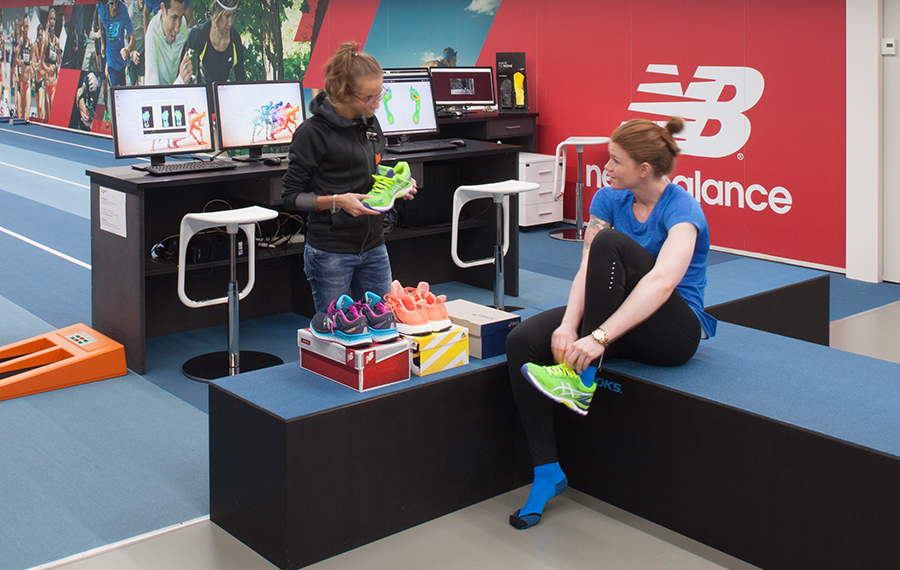Bought running shoes online? Then read our tips and guidelines here to check if the shoe fits properly.
Finally, your package of new running shoes has been delivered. The temptation at such a time may be to go straight out for a reconnaissance run. We still want to give you a break. This is because every foot is different so the size and fit will not feel equally comfortable for everyone. By trying them on indoors first, the shoes are still in perfect condition and can be returned or exchanged if necessary. We compiled for you a checklist of points of interest that you should definitely check before exposing your shoes to the outdoors.
Checklist
Control of size
How do you test the size?
- Always try on the shoes with your favorite technical running socks, not thin cotton socks.
- Check the size of the shoe while standing upright.
- Always test both feet, as your feet are often not the same length and/or width.
- Check both the length and width of your shoe.
The length of the shoe
- Running shoes always take a size or a size and a half larger than your regular shoes. Why? In fact, while walking or during the day, your feet expand up to an inch. We recommend leaving 5 to 10 mm of space at the toes. Unpleasant pressure on your toes, a cramped walking position or blue toenails can thus be prevented.
- It is normal to have some extra space at the level of your toes. This freedom needs your toes, believe us.
The width of the shoe
- Make sure the shoe fits nicely around the heel and at midfoot level.
- The lace holes on the left and right should be almost parallel, after you have laced the shoes properly. Are the lace holes coming apart? Then the shoes are too narrow. Do you have to axe them completely? Then your shoe is too wide.
- Does the shoe pinch in width or can you clearly see that your foot is bulging above the sole of the shoe, so to speak? Then it’s best to look for a wider model.
- Are you too loose in the shoe, do you have too much slack or do you find that you have to pull the laces abnormally hard? Then it’s best to choose a narrower model.
Tip!
Also compare with your old running shoes if necessary. How much space did you have left in there? Put the insoles of both shoes on top of each other for a moment to see if there is much difference.
Control of fit and feel
A shoe should feel good and natural from the start. To verify that feeling, it is best to walk and/or run indoors with your new shoes on a clean surface.
- Is it a model/brand you already have? Then the model will probably feel familiar.
- Is it a model/brand different from the shoes you are used to? Chances are then you will have to get used to the shoes for a while, but of course they should not feel uncomfortable.
- Make sure the heel cap fits nicely so that the heel does not slip out of the shoe. Use the loop lacing technique if necessary, which will cause your heel bone to lock more firmly, giving you more support around the heel. This technique is definitely recommended if you also use orthotics in these shoes.
- If you use orthotics, always remove the original insole before placing the orthotics in the shoes.
- If anything feels uncomfortable, take them off for a while and try them again a while later. If you still have the same feeling then the fit is not ideal for you.
After going through this checklist, do you still have questions or doubts? Then make an appointment to visit one of our stores or ask our advisors for advice via WhatsApp at +32 479 06 65 99. They are also available to you online from Monday to Saturday between 9:30-18:00.
Advice on breaking in running shoes.
Are the size and fit approved? Then you are ready to walk or hike them in. Be sure to break in the shoes slowly, especially if the new running shoes are not a familiar model or brand. This allows your body to get used to the characteristics of your new shoes and allows the shoes to adapt to you.
- Run several shorter runs first and then gradually increase the distance.
- If necessary, alternate the new running shoe with your old pair. This gives your body a chance to “recuperate” from the changed load for a while.
- Do you feel minor discomfort in the beginning? Better walk in the shoes then, before using them to walk with.
- While running in and walking in the shoes, you should notice a positive evolution.

